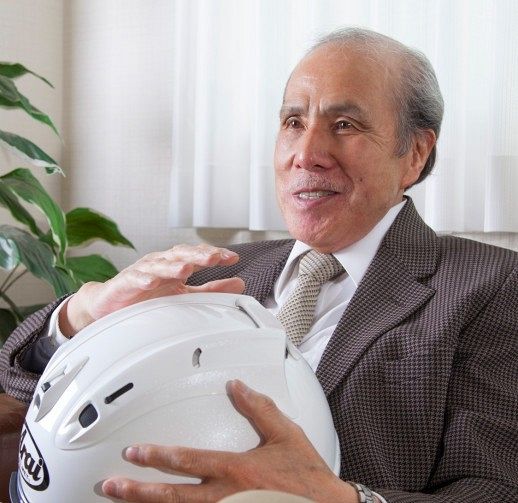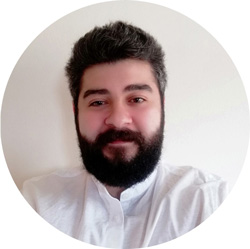My father didn’t go to college. He didn’t even finish high school. He was the son of a hat maker in Tokyo, and his hobby was motorcycling. He rode a motorcycle with no helmet—just a straw hat. In those days, there weren’t any motorcycle helmets.
My father used to say, “I am a good rider.” I don’t think he was, but he loved to ride a motorcycle. I like motorcycles, too. I really like motorcycles.
During World War II, Japanese soldiers were sent to Southeast Asia, and it was really hot. They needed something for heat isolation, but at the same time it had to have ventilation.
My father came up with something new. He cut bamboo and made a cage. Over that, he put something like a washcloth. The army liked it, which was good for him; he didn’t get drafted.
After the war, he tried other businesses. He liked to invent things, not just making, buying, and selling. The first headgear he could think of was for construction and mining workers. They needed protection. In those days, even the construction helmet was new. He had to make everything.
My father could have survived by making helmets for construction and mining workers. Instead, he decided to make motorcycle helmets for a market that didn’t exist. He modified a shell that he had made for construction.
That was the late 1940s. I was in grammar school. I saw him making helmets. What I remember was, the first shell was canvas with resin. This is where my father made that helmet. The building is different but the location is the same.
The first market was for gamble racing. It’s dirt track, like betting on horses. Naturally, they had a lot of crashes and injuries. They approached my father, and he said he would supply helmets. He made the first commercial motorcycle helmet in Japan.
My father didn’t know much about chemicals. He read an article about fiberglass. He said, “This may be good.” I still don’t know what he did, but he went to some professor at a college and found out how to make a fiberglass half shell. That was the first fiberglass shell in this country.
He lined the first helmet with cork. That was the first thing he thought of and could get hold of. He noticed an article about Styrofoam, and he somehow made a Styrofoam liner. There was no mold, so he made a mold himself and put the liner in a fiberglass shell. He set the basis for the modern motorcycle helmet.
There was another helmet company: Bell. Roy Richter was the owner. I used to know him very well. My father started on the other side of the world, so we don’t know who was the first, but my father didn’t copy anybody.
Before my father, there was no helmet business in this country. He started an industry that has gotten bigger and bigger and bigger.
I was born with helmets, and I raced with helmets. So a helmet is like a part of my body.
To make a helmet better, you must test. There was no device to test, so my father made a device: a junk helmet, a head form, and a rope. That was very primitive, but at least you could tell which one was better. When our government started to think about writing a standard, they naturally looked to my father.
My father made a “bird’s nest” shaped from fiberglass. He put the nest in a mold, added resin, and applied heat and pressurized it with an air bag to make a shell. That was the way my father started, and we still do it that way.
I decided if we could make a shell with strict pressurized control we would have an edge. I tried to establish a foolproof system, but there was no such way. The final answer was very good care with every shell.
My father never thought of using racing for promotion. He didn’t even think of promoting the brand. But as the industry started to grow, he thought maybe we could make a business.
I used to race sports cars as a semi-professional. I was a pretty good driver—I still am—but I knew that I would never be number one. So one day I decided this will be my business.
The difference between my father and me was I liked to race. I wanted to compete. My father enjoyed riding. He enjoyed life. If he was happy and healthy, he was okay. I like to win. Arai was losing. I said to my father, “Those guys are getting bigger. We must do something.” He said, “Okay, you take over.” That was 1975.
One day, a journalist from a motorcycle magazine came to me. She asked, “What are you going to do?” She was wearing a Bell. I said, “I am going after Bell.”
Racers have more chance to use protection, so I thought involvement in racing might be the way. Dominating this country didn’t take too much. In less than a year, I controlled all of Japan. We started to get acknowledged. Then it was time to go overseas.
Ted Boody Jr. was the first American racer to wear an Arai helmet. He was 18 years old when I first met him. He said, “Hey, this fits okay!” We signed a contract, and he won the first race wearing our helmet. That was at the Houston Astrodome. We still use the name “Astro.”
I believe in nature. To me, nature is an example. I always want to make a helmet that is smooth, like an egg. So when I design a shell, if it doesn’t follow the basic contour of my head, I don’t feel comfortable. I think this is right.
We didn’t design the helmet to take the shape of an egg, but we wanted to make it more comfortable, to feel better, for protection. What we got was a shape that looks the same as an egg. Nature led to the solution.
Business is competition. If you don’t win, you go out of business. To stay in business, you’ve got to make profit. Of course, I want to make more money, but more important is if I can win the battle for protection.
We make our helmets to meet standards while maintaining the shape. This is something nobody else does. To maintain the ability to “glance off,” we maintain strict control of the characteristic of the lamination from location to location.
Maintaining this shape with a fiberglass shell while meeting new standards is really difficult because requirements can vary from one location to another. To maintain the basic shape that feels “comfortable,” you have to change the characteristics of the liner from location to location.
I admired Dr. Snively at Snell. He had guts. Without Snively, there wouldn’t have been a Snell standard.
We want to do the best we can on every shell. That is number one. We don’t make special shells. From the beginning, the only thing we could do was the best in everything we make.
If a new model has to sacrifice protection, that is not innovation. Accumulating small differences, little by little, that is the history of Arai.
Our ambition is good protection. That is the basis for Arai. We have to make a good helmet.













24
Comment